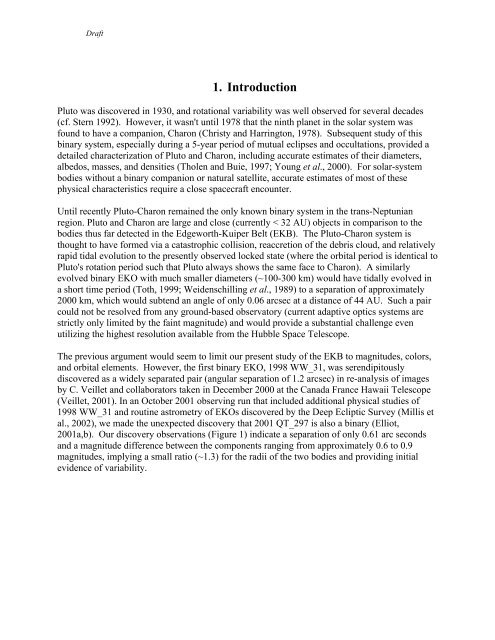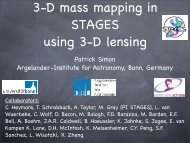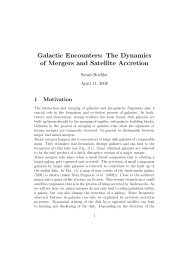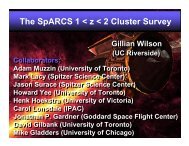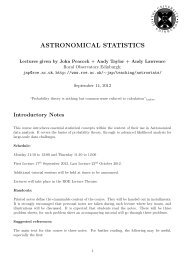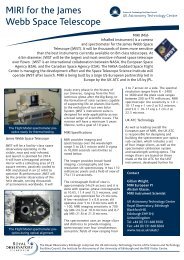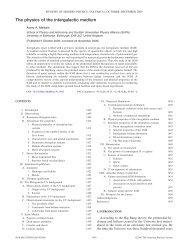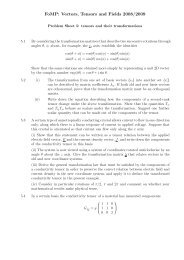Physical Characterisation of the Binary EKBO 2001 QT297
Physical Characterisation of the Binary EKBO 2001 QT297
Physical Characterisation of the Binary EKBO 2001 QT297
Create successful ePaper yourself
Turn your PDF publications into a flip-book with our unique Google optimized e-Paper software.
Draft<br />
1. Introduction<br />
Pluto was discovered in 1930, and rotational variability was well observed for several decades<br />
(cf. Stern 1992). However, it wasn't until 1978 that <strong>the</strong> ninth planet in <strong>the</strong> solar system was<br />
found to have a companion, Charon (Christy and Harrington, 1978). Subsequent study <strong>of</strong> this<br />
binary system, especially during a 5-year period <strong>of</strong> mutual eclipses and occultations, provided a<br />
detailed characterization <strong>of</strong> Pluto and Charon, including accurate estimates <strong>of</strong> <strong>the</strong>ir diameters,<br />
albedos, masses, and densities (Tholen and Buie, 1997; Young et al., 2000). For solar-system<br />
bodies without a binary companion or natural satellite, accurate estimates <strong>of</strong> most <strong>of</strong> <strong>the</strong>se<br />
physical characteristics require a close spacecraft encounter.<br />
Until recently Pluto-Charon remained <strong>the</strong> only known binary system in <strong>the</strong> trans-Neptunian<br />
region. Pluto and Charon are large and close (currently < 32 AU) objects in comparison to <strong>the</strong><br />
bodies thus far detected in <strong>the</strong> Edgeworth-Kuiper Belt (EKB). The Pluto-Charon system is<br />
thought to have formed via a catastrophic collision, reaccretion <strong>of</strong> <strong>the</strong> debris cloud, and relatively<br />
rapid tidal evolution to <strong>the</strong> presently observed locked state (where <strong>the</strong> orbital period is identical to<br />
Pluto's rotation period such that Pluto always shows <strong>the</strong> same face to Charon). A similarly<br />
evolved binary EKO with much smaller diameters (~100-300 km) would have tidally evolved in<br />
a short time period (Toth, 1999; Weidenschilling et al., 1989) to a separation <strong>of</strong> approximately<br />
2000 km, which would subtend an angle <strong>of</strong> only 0.06 arcsec at a distance <strong>of</strong> 44 AU. Such a pair<br />
could not be resolved from any ground-based observatory (current adaptive optics systems are<br />
strictly only limited by <strong>the</strong> faint magnitude) and would provide a substantial challenge even<br />
utilizing <strong>the</strong> highest resolution available from <strong>the</strong> Hubble Space Telescope.<br />
The previous argument would seem to limit our present study <strong>of</strong> <strong>the</strong> EKB to magnitudes, colors,<br />
and orbital elements. However, <strong>the</strong> first binary EKO, 1998 WW_31, was serendipitously<br />
discovered as a widely separated pair (angular separation <strong>of</strong> 1.2 arcsec) in re-analysis <strong>of</strong> images<br />
by C. Veillet and collaborators taken in December 2000 at <strong>the</strong> Canada France Hawaii Telescope<br />
(Veillet, <strong>2001</strong>). In an October <strong>2001</strong> observing run that included additional physical studies <strong>of</strong><br />
1998 WW_31 and routine astrometry <strong>of</strong> EKOs discovered by <strong>the</strong> Deep Ecliptic Survey (Millis et<br />
al., 2002), we made <strong>the</strong> unexpected discovery that <strong>2001</strong> QT_297 is also a binary (Elliot,<br />
<strong>2001</strong>a,b). Our discovery observations (Figure 1) indicate a separation <strong>of</strong> only 0.61 arc seconds<br />
and a magnitude difference between <strong>the</strong> components ranging from approximately 0.6 to 0.9<br />
magnitudes, implying a small ratio (~1.3) for <strong>the</strong> radii <strong>of</strong> <strong>the</strong> two bodies and providing initial<br />
evidence <strong>of</strong> variability.


